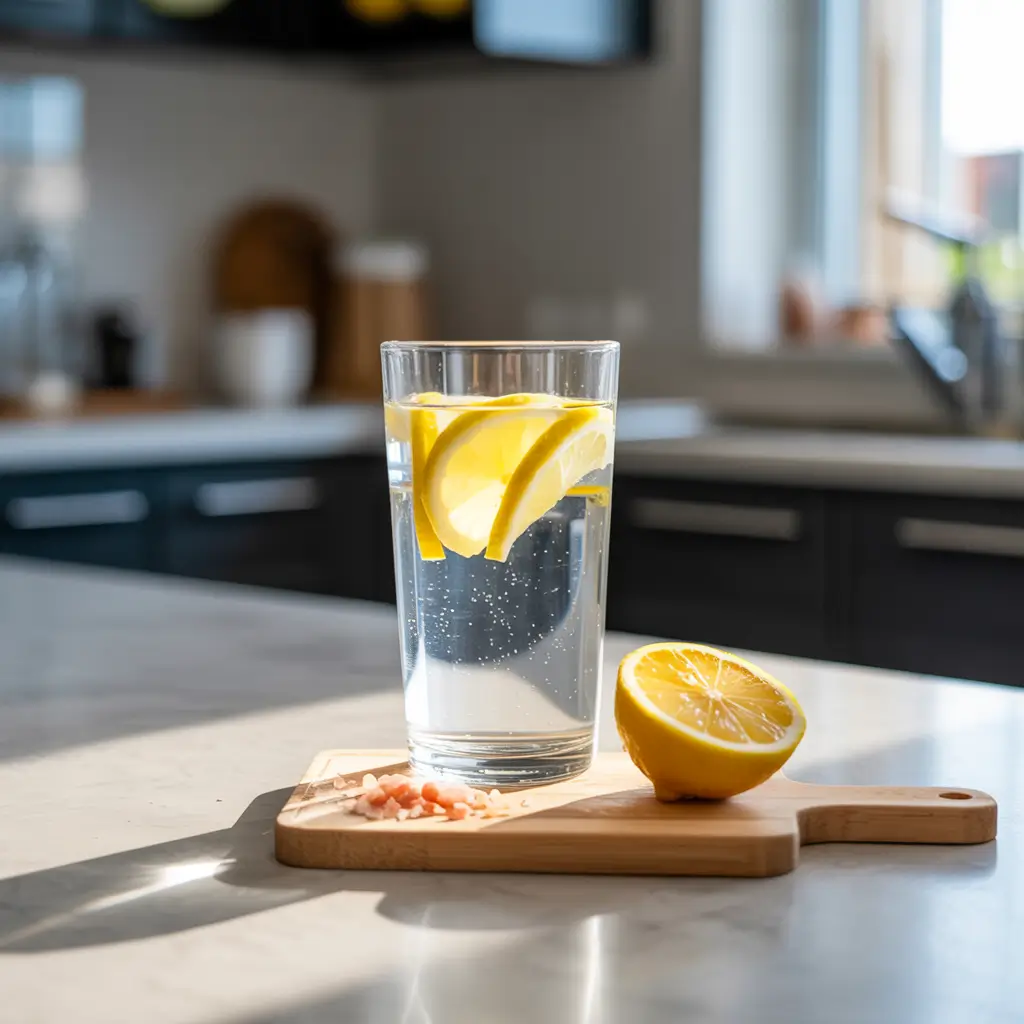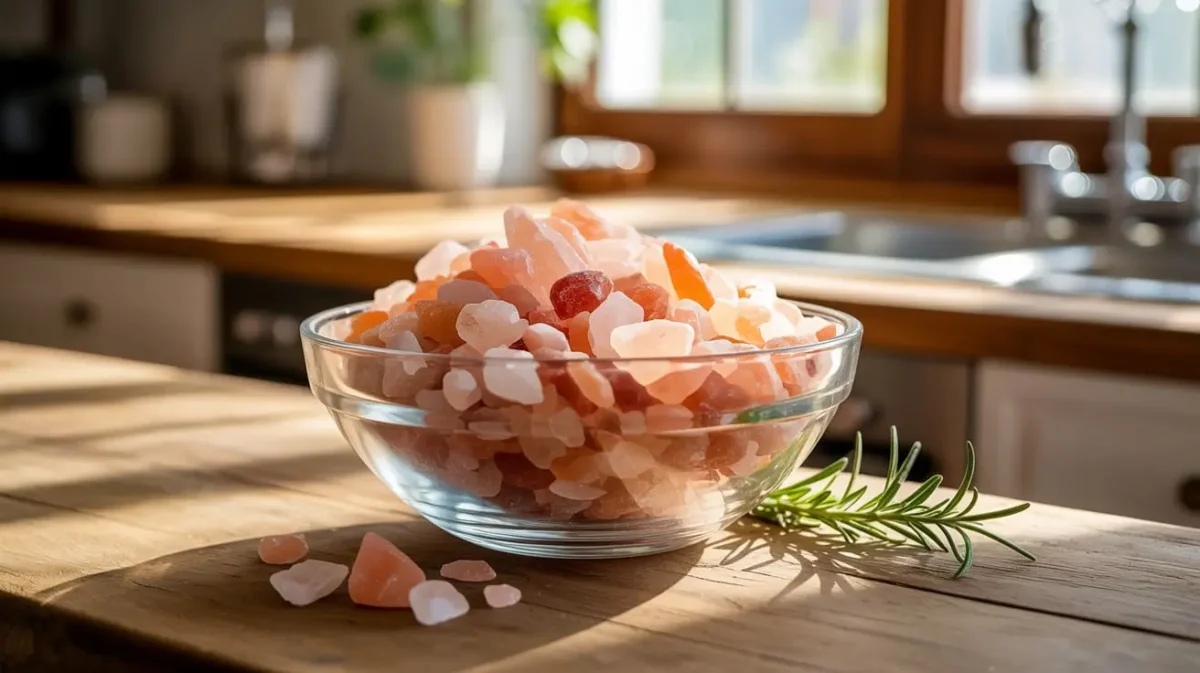Introduction
The pink Himalayan salt diet has gained massive popularity among health enthusiasts looking for natural ways to improve wellness. Unlike regular table salt, pink Himalayan salt is minimally processed and contains trace minerals like magnesium, potassium, and calcium that give it a distinctive rosy hue. Advocates claim it supports hydration, digestion, and even weight loss. But how true are these claims, and how should you use it daily?
In this guide, we’ll explore the benefits of the pink Himalayan salt diet, its role in weight management, safe consumption levels, and simple ways to include it in meals. We’ll also answer common questions such as “Is pink Himalayan salt good for weight loss?” and “Can I eat Himalayan pink salt every day?” to help you make an informed choice.
Looking for inspiration? Try checking out this guide on mindful nutrition for holistic wellness ideas. Don’t miss our Facebook page where we share healthy lifestyle tips and updates.
table of contents
Table of Contents
Pink Himalayan Salt Diet: Benefits, Uses, and Weight Loss Insights
The Pink Himalayan Salt Diet has become a popular wellness trend thanks to its trace minerals, natural purity, and potential benefits for hydration, digestion, and weight management.
- Prep Time: 5 minutes
- Cook Time: 0 minutes
- Total Time: 5 minutes
- Yield: Varies by use
- Category: Health & Wellness
- Method: No Cooking Required
- Cuisine: Global
Ingredients
- Pink Himalayan salt (as daily seasoning)
- Filtered water (for sole water and detox drinks)
- Fresh vegetables (salads, grilled, or roasted)
- Lean proteins (chicken, fish, eggs)
- Whole grains (quinoa, brown rice, oats)
- Fruits (watermelon, cucumber, avocado)
- Herbal teas or smoothies (for hydration with added minerals)
Instructions
- Replace regular table salt with pink Himalayan salt in daily cooking for a cleaner, additive-free option.
- Prepare sole water by mixing 1 teaspoon of Himalayan salt in a glass of filtered water to support hydration and mineral balance.
- Sprinkle pink salt over grilled vegetables, lean proteins, or breakfast meals like avocado toast and scrambled eggs.
- Add a small pinch of pink salt to smoothies or electrolyte drinks for post-workout recovery.
- Use Himalayan salt blocks for grilling or serving meals to enhance flavor naturally.
- Pair Himalayan salt use with a nutrient-rich diet and regular hydration for best results.
Notes
Use pink Himalayan salt in moderation to stay within daily sodium guidelines (1,500–2,300 mg). It should complement a balanced diet, not replace essential nutrient sources.
Understanding the Pink Himalayan Salt Diet
What is pink Himalayan salt diet ?
Pink Himalayan salt is a type of rock salt extracted from ancient sea beds located in the Punjab region of Pakistan, at the base of the Himalayan mountains.Unlike conventional table salt that goes through extensive processing and loses most of its natural minerals, this variety is hand-extracted with care and kept nearly unrefined. Its distinctive pink hue comes from the presence of trace minerals, which also give it a richer nutritional profile. Because of its purity and unique appearance, it has become a popular alternative to conventional salt in kitchens around the world.
Nutritional Profile and Mineral Content
Supporters of the pink Himalayan salt diet often highlight its wide range of trace minerals. While pink Himalayan salt diet still consists mainly of sodium chloride, it naturally carries small amounts of potassium, magnesium, calcium, and iron. These elements not only account for its rosy tint but also provide added health benefits when compared with ordinary table salt.
Here’s a closer look at the minerals found in Himalayan salt and their key roles:
| Mineral | Primary Benefit |
|---|---|
| Sodium | Helps regulate hydration and fluid balance |
| Potassium | Promotes healthy heart function and muscle activity |
| Magnesium | Supports energy production and relaxation |
| Calcium | Contributes to stronger bones and teeth |
| Iron | Enhances oxygen transport and blood quality |
Although the quantities of these minerals are relatively small, many people choose Himalayan salt because it is free from artificial additives such as bleaching agents and anti-caking compounds often found in processed table salt. Instead, it offers a more natural and cleaner seasoning option for cooking, flavoring meals, or even mixing into detox drinks.
Switching to Himalayan salt doesn’t mean it should be your only source of nutrients, but it can serve as a healthier, additive-free choice that supports a balanced lifestyle.
Health Benefits of the Pink Himalayan Salt Diet

Mineral Balance and Hydration
One of the biggest draws of the pink Himalayan salt diet is its ability to support hydration and mineral balance. Since it contains trace elements like potassium, magnesium, and calcium, many people believe it helps the body maintain electrolyte levels more effectively than refined table salt. This can be especially useful for those who exercise regularly or live in hot climates, where hydration is crucial. Some wellness enthusiasts even prepare “sole water,” a mixture of Himalayan salt and water, as a natural electrolyte drink.
Impact on Digestion and Metabolism
Another potential benefit is pink Himalayan salt diet effect on digestion. Pink Himalayan salt is thought to stimulate the production of digestive enzymes, which can improve nutrient absorption and reduce bloating. Supporters of the Himalayan salt diet also claim it may boost metabolism by encouraging a better balance of fluids and minerals in the body. While these claims are not strongly backed by scientific studies, anecdotal evidence suggests many users experience reduced water retention and better gut health when using Himalayan salt in moderation.
Compared to table salt, which often contains additives and preservatives, pink Himalayan salt offers a more natural approach. By replacing heavily processed salt with a mineral-rich alternative, you’re giving your body cleaner seasoning that may support overall wellness.
pink Himalayan salt diet and Weight Loss
Is Pink Himalayan Salt Good for Weight Loss?
Many people turn to the pink Himalayan salt diet in hopes of shedding extra pounds. While salt itself doesn’t directly burn fat, Himalayan salt may support weight loss in indirect ways. Its trace minerals can help regulate hydration, reduce water retention, and maintain electrolyte balance—factors that sometimes influence body weight. Unlike refined table salt, which can cause bloating when consumed in excess, pink salt is considered a gentler option on the digestive system.
Some nutritionists believe that using Himalayan salt in place of processed salt might help reduce cravings, as it can improve the body’s mineral intake. This, in turn, may lead to healthier eating habits that support long-term weight management.
The Himalayan Salt Trick for Weight Loss Explained
A trending concept is the “Himalayan salt trick,” often promoted in wellness communities. This usually involves drinking a glass of water mixed with a small amount of pink salt, sometimes called “sole water.” Advocates claim this mixture boosts metabolism, flushes out toxins, and supports fat burning.
However, scientific evidence for this “trick” is limited. The benefits likely come from improved hydration and balanced electrolytes, which can reduce bloating and help you feel more energized during workouts.
Used wisely, pink Himalayan salt can be part of a healthy diet and active lifestyle, but it should not be seen as a magic solution for weight loss.
Daily Consumption Guidelines
Can I Eat Himalayan Pink Salt Every Day?
A common question about the pink Himalayan salt diet is whether it’s safe for daily use. The short answer is yes—but in moderation. pink Himalayan salt diet , similar to other types of salt, is mainly composed of sodium chloride. While the trace minerals set it apart from table salt, excessive sodium intake can still raise blood pressure and increase the risk of heart problems.
Most health experts recommend limiting total salt intake to around 2,300 mg of sodium per day (roughly one teaspoon). For people with high blood pressure or certain health conditions, the ideal limit may be closer to 1,500 mg per day. Using Himalayan salt daily is safe if you stay within these guidelines.
Recommended Daily Intake vs. Regular Table Salt
Nutritionally, pink Himalayan salt diet contains slightly less sodium per teaspoon than refined table salt, thanks to its larger, less dense crystals. This means you may naturally consume less sodium when seasoning with pink salt. Plus, it’s free of additives like anti-caking agents, making it a cleaner option.
Here’s a quick comparison:
| Salt Type | Sodium (per tsp) | Additives |
|---|---|---|
| Pink Himalayan Salt | ~1,680 mg | None |
| Table Salt | ~2,300 mg | Often yes |
Using Himalayan salt in daily cooking, detox drinks, or seasoning is perfectly fine. The key is balance—don’t exceed your daily sodium limit, and pair pink Himalayan salt diet with nutrient-rich foods for a healthy diet.
How to Use pink Himalayan salt diet

Cooking and Seasoning with Pink Himalayan Salt diet
One of the simplest ways to follow the pink Himalayan salt diet is by swapping regular table salt with Himalayan salt in everyday cooking. Its coarse texture and mild flavor make it a versatile seasoning for meats, vegetables, soups, and even baked goods. Many chefs prefer it because it enhances natural flavors without tasting overly salty. You can also find Himalayan salt blocks, which can be used as a cooking surface to grill or serve food with a subtle mineral touch.
Detox Drinks, Sole Water, and Weight-Loss Recipes
Another popular method is incorporating Himalayan salt into drinks. A well-known recipe is “sole water,” made by dissolving a teaspoon of pink salt in a glass of filtered water. Supporters claim this mixture helps with hydration, improves digestion, and may reduce bloating—making it a common addition to weight-loss routines.
Pink Himalayan salt can also be added to homemade electrolyte drinks, smoothies, or detox teas to replenish minerals after exercise. Some people sprinkle it on fruit like watermelon or cucumbers for a refreshing, low-calorie snack.
If you’re experimenting with recipes, start small. Just a small sprinkle of pink salt can enhance the flavor of both savory meals and sweet treats. Used creatively, it can be more than just a seasoning—it can become a functional part of your diet. Check out creative meal and recipe ideas on our Pinterest board for more ways to include pink Himalayan salt in your diet.
Risks and Considerations
Sodium Concerns and Blood Pressure
While the pink Himalayan salt diet is often marketed as healthier than table salt, it still carries the same risks tied to sodium consumption. Too much sodium can increase blood pressure, strain the heart, and raise the risk of stroke or kidney issues. Even though Himalayan salt contains trace minerals, they are present in very small amounts and don’t offset the dangers of excess sodium. This is why moderation remains key.
Another misconception is that Himalayan salt is “low-sodium.” In reality, it contains slightly less sodium per teaspoon than refined salt due to its crystal size, but the difference is minor. Consuming large quantities will still push you over the recommended daily sodium limits.
Who Should Avoid Pink Himalayan Salt diet?
Certain groups of people should be especially careful when adopting the pink Himalayan salt diet . Individuals with high blood pressure, kidney disease, or heart conditions should consult a healthcare professional before increasing their salt intake. Pregnant women and older adults may also need stricter limits.
Additionally, relying solely on Himalayan salt for mineral intake isn’t practical. While it contains calcium, potassium, and magnesium, the levels are far too low to meet daily requirements. These minerals should primarily come from whole foods like leafy greens, nuts, seeds, and legumes.
In short, Himalayan salt can be part of a healthy lifestyle when used wisely, but it’s not a free pass to consume more sodium. Balance is essential.
Comparing Pink Himalayan Salt with Other Salts
Himalayan Salt vs. Table Salt
A key reason many people switch to the pink Himalayan salt diet is the difference between Himalayan salt and refined table salt. Table salt is heavily processed, often bleached, and mixed with additives like anti-caking agents to keep it from clumping. It usually contains iodine, added to prevent deficiencies, but lacks other natural minerals.
Himalayan salt, on the other hand, is minimally processed and naturally free of additives. Its larger crystals mean you often use less by volume, which can help reduce sodium intake. The subtle mineral content also gives it a more complex flavor compared to the sharp saltiness of table salt.
Himalayan Salt vs. Sea Salt
Another comparison is Himalayan salt versus sea salt. Both are considered natural options, but they differ in source and purity. Sea salt is harvested from evaporated seawater, which can sometimes contain microplastics or pollutants due to ocean contamination. Himalayan salt comes from ancient deposits protected underground for millions of years, making it less likely to carry modern pollutants.
Nutritionally, both provide trace minerals, but Himalayan salt is often preferred for its purity and appealing color. Sea salt, however, may contain slightly higher amounts of certain minerals depending on its origin.
Ultimately, choosing between salts comes down to preference and lifestyle. Himalayan salt offers purity and aesthetics, while sea salt provides a similar natural alternative. Both can be healthier than refined table salt when used in moderation.
Lifestyle Integration and pink Himalayan salt diet Plans

Pink Himalayan Salt Diet Meal Ideas
Adopting the pink Himalayan salt diet doesn’t require drastic changes—it’s about replacing regular salt with a cleaner, mineral-rich option. Start with simple swaps in your meals. Sprinkle Himalayan salt over grilled vegetables, roasted chicken, or salads to enhance natural flavors. Add a pinch to soups, stews, or whole-grain dishes like quinoa and brown rice for balanced seasoning. Even breakfast options like avocado toast or scrambled eggs can benefit from its subtle flavor.
You can also experiment with Himalayan salt blocks. These slabs can be heated for cooking meats or chilled for serving sushi, cheese, or fruit, giving your dishes a gourmet touch while keeping preparation natural.
Combining Himalayan Salt with Exercise and Hydration
The Himalayan salt diet is often paired with active lifestyles because of its ability to support hydration and electrolyte balance. Athletes sometimes add a small pinch of pink salt to water or smoothies to replace electrolytes lost through sweat. This can help reduce muscle cramps and improve endurance.
Pairing pink salt with nutrient-dense foods like leafy greens, lean proteins, and whole grains creates a balanced approach that supports weight management and energy. Adding hydration strategies—such as sipping sole water or a homemade electrolyte drink—makes it easier to stay energized during workouts.
By weaving Himalayan salt into both meals and hydration routines, you can create a sustainable diet plan that supports wellness without feeling restrictive.
FAQs about Pink Himalayan Salt Diet
Is Pink Himalayan Salt Good for Weight Loss?
Yes, but indirectly. The pink Himalayan salt diet doesn’t burn fat on its own, but it may help with hydration, reduce bloating, and support digestion. These effects can make weight management easier when paired with a healthy diet and exercise.
What is the Himalayan Salt Trick for Weight Loss?
The so-called “salt trick” often refers to drinking sole water—a mix of pink Himalayan salt and water. Supporters claim it boosts metabolism, flushes toxins, and curbs cravings. While scientific evidence is limited, the hydration and mineral balance may support weight-loss efforts.
Can I Eat Himalayan Pink Salt Every Day?
Yes, you can, but moderation is essential. Even though Himalayan salt is more natural than table salt, it’s still mostly sodium chloride. Stick to daily sodium guidelines (1,500–2,300 mg) to avoid risks like high blood pressure.
How to Use Himalayan Salt in Diet?
You can use Himalayan salt in place of table salt for cooking and seasoning. It also works well in detox drinks, electrolyte beverages, and as a garnish for fruits or smoothies. Start with small amounts, since the crystals are more flavorful and less dense than refined salt.
Conclusion
Pink Himalayan salt is more than just a trendy seasoning—it’s a natural option that brings subtle flavor and essential trace minerals to your meals. Unlike processed table salt, it is minimally refined and can support hydration, digestion, and mineral balance when used wisely. Many people enjoy it in cooking, wellness drinks, or even as part of detox routines.
Still, it’s important to remember that it is not a miracle cure and should be consumed in moderation, just like any other salt. By pairing it with a nutrient-rich diet, proper hydration, and a balanced lifestyle, Himalayan salt can become a simple yet valuable addition to your overall wellness journey.
Don’t miss our nutrition and lifestyle tips at Zestolla for more ways to build a balanced, health-focused routine.


